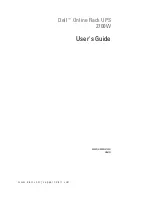
D:\manual\UM_PCM-WOW\UM_WOW-300(S)\661-WOW3-000-31.doc
- 5 -
1.8 RS-232 Interface port (Option)
Provide both RS-232 and UPSMON software to support NOVELL, UNIX, DOS,
WINDOWS and other operating systems.
2. I
NSTALLATION
2.1 Recharge the battery
UPS may be used by anyone immediately upon receipt. The battery is fully charged
before shipped from the factory. However, user is recommended to recharge the
battery at least four hours before using UPS. Energy loss may occur during shipping
or long duration storage. To recharge the battery, simply let UPS be plugged into an
AC outlet and switch it on.
2.2 Connect the loads
Plug your primary equipment (e.g. computer, monitor and critical data storage
device, etc.) to the Battery backup outlets. Plug your peripheral equipment (e.g.
printer, scanner, fax, or audio device) to the Full-time Bypass Protection outlets. Do
not plug laser printer to the UPS, as its power demand is much higher than typical
peripherals and may cause the circuit breaker (or fuse) to trip.
2.3 Connect the telephone
If you wish to protect a fax or a modem, connect the telephone cable from the wall
outlet to the “IN” jack. Connect the telephone cable (provided) from the “OUT” jack
to the fax or modem. To protect a10/100Base-T (UTP) network interface, obtain and
use a UTP cable to connect the “OUT” jack to your computer.
2.4 Connect to the utility power
Plug UPS to a 2-pole, 3-wire grounding receptacle. Make sure the battery supply
outlets of the UPS do not service equipment requiring heavy electricity (e.g.
refrigerator, air conditioner, copier, etc.).
Attention:
When using extension cords, make sure the total rating of the loads is
suitable.
‘
2.5 UPS self-test
UPS will conduct a self-test once switched on it each time. Besides this, switch on
your equipment after switch on UPS. This function is disabled while buzzer is
alarmed caused by full (over) loads.
2.6 Battery auto-charging
The internal battery would be charged by charging circuit automatically, while utility
power is connected to the unit,
2.7 Auto restart feature
UPS would shut-down while battery voltage is too low, and wake up automatically
when utility power is normal.
D:\manual\UM_PCM-WOW\UM_WOW-300(S)\661-WOW3-000-31.doc
- 6 -
2.8 Overload protection
AC Mode: If load exceeds 100% of nominal rating, buzzer is keeping beep.
Backup Mode: UPS automatic shutdown, if overload exceeds 110% of nominal
rating at 1 sec.
2.9 Optimal battery status
To maintain the optimal battery status, leave UPS plugged in and switched on at all
time.
2.10 No load Shutdown feature
UPS is equipped with no load shutdown function. While no loads are connected to
the UPS, the unit will automatically shutdown after an hour.
3. O
PERATION
3.1 Simple test
It is recommended that the user perform a simulation test when using UPS for the
first time or when adding an additional piece of equipment. Conduct a
simulation-test: first, switch on UPS and wait for the power indicator to light up, then
simply unplug UPS to simulate the event of utility failure.
3.2 Check the power requirement of your equipment
3.2.1. Make sure the total power of your equipment does not exceed rating capacity.
3.2.2. Also make sure the equipment you plugged into the Battery Power-Supplied
outlets does not require total power exceeding the capacity of the UPS. Otherwise,
overload may occur and cause the circuit breaker to trip. If the power requirement of
your equipment differs from VA, convert the requirement power into VA by doing the
calculations below:
3.2.3. If the power requirement of your equipment is listed other than VA, convert the
requirement into VA by doing the calculations below.
Watt (W) X 1.81 = VA
3.3 Limited rating power of UPS
When utility power failure occurs, the battery power outlets will supply power to your
equipment from its battery. The buzzer will beep once every 4 seconds. Be sure that
your equipment is running under the limited rating power. To restore the battery
power by plugging UPS back in to the existing power source. Perform the self-test to
make sure UPS works properly.























